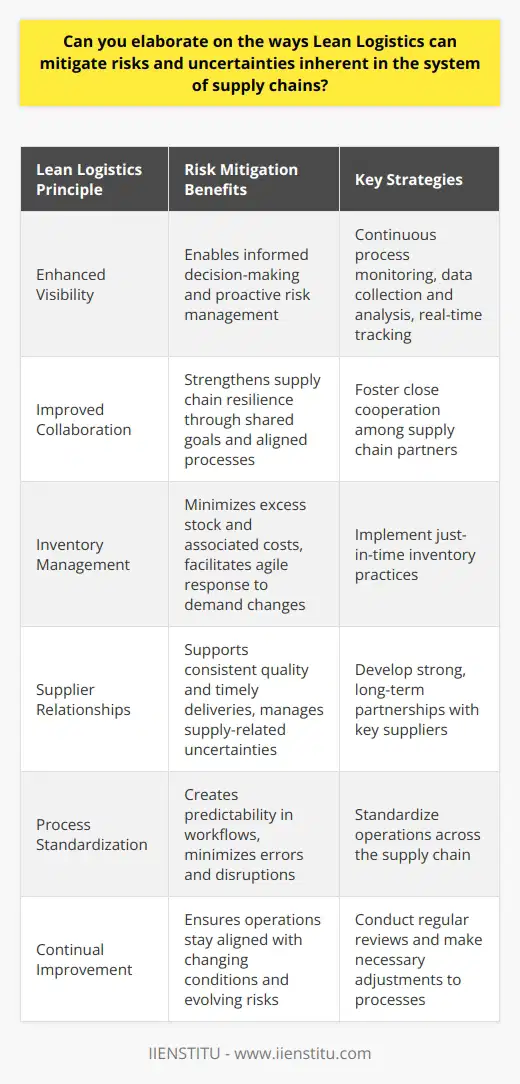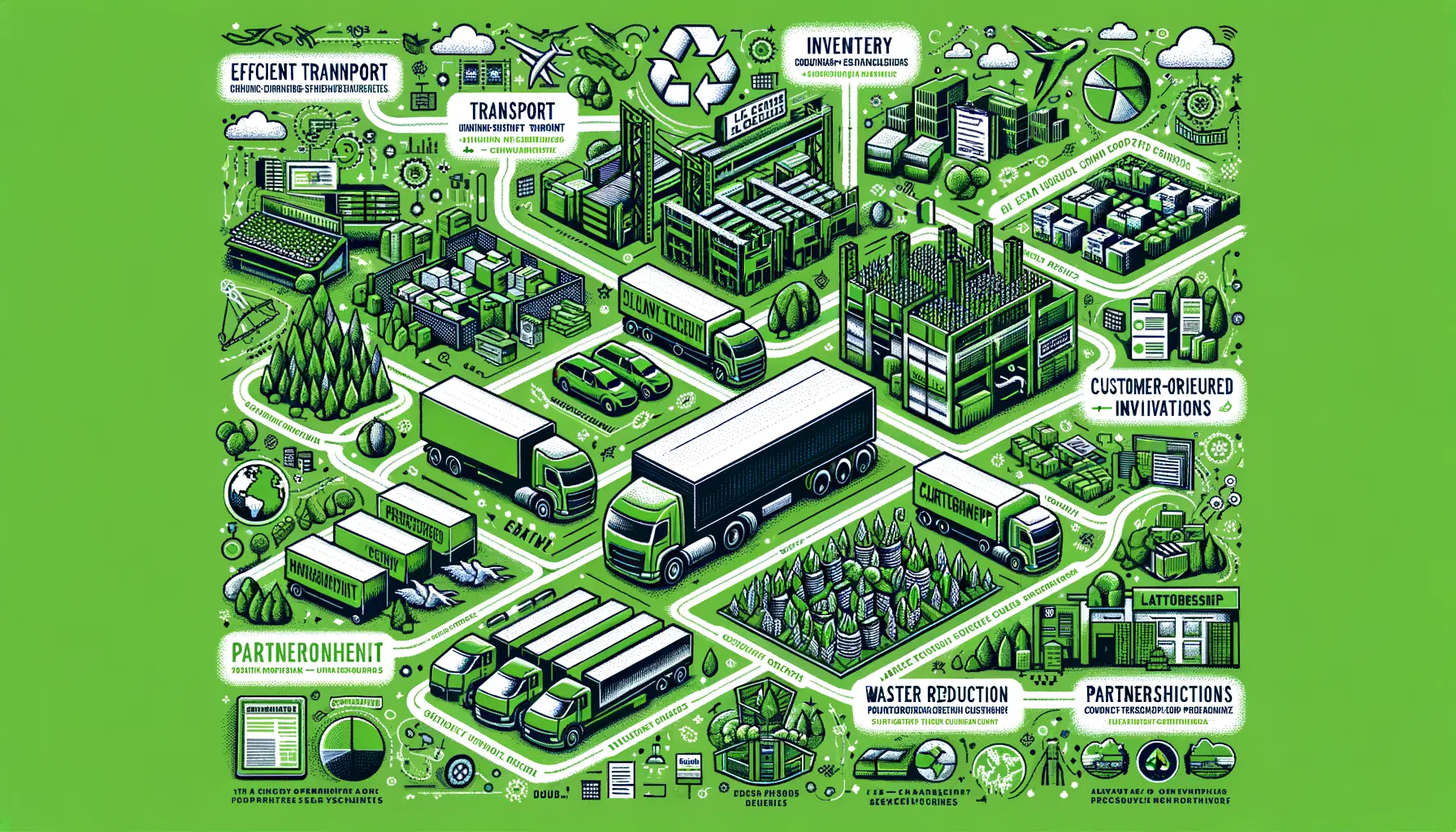
In today's fast-paced and highly competitive business environment, lean logistics has emerged as a game-changing approach to streamlining supply chain operations. By embracing the principles of lean thinking, organizations can unlock unprecedented levels of efficiency, agility, and customer satisfaction. As someone who has witnessed the transformative power of lean logistics firsthand, I am excited to share my insights and experiences on this fascinating topic.
At its core, lean logistics is all about eliminating waste and maximizing value. It is a philosophy that challenges us to rethink every aspect of our supply chain, from sourcing raw materials to delivering finished products to customers. By identifying and eliminating non-value-adding activities, we can create a more streamlined and efficient logistics process that delivers superior results.
One of the key benefits of lean logistics is its ability to reduce lead times and improve responsiveness to customer demands. In today's world, customers expect faster and more reliable delivery than ever before. By implementing lean principles such as just-in-time delivery and continuous flow, we can significantly reduce the time it takes to get products to market. This not only enhances customer satisfaction but also helps to reduce inventory costs and improve cash flow.
Another important aspect of lean logistics is its focus on continuous improvement. Rather than settling for the status quo, lean organizations are always looking for ways to optimize their processes and eliminate waste. This requires a culture of experimentation, collaboration, and learning. By empowering employees to identify and solve problems, we can create a more agile and adaptive logistics operation that can quickly respond to changing market conditions.
Of course, implementing lean logistics is not without its challenges. It requires a significant shift in mindset and a willingness to embrace change. Many organizations struggle with the idea of letting go of traditional logistics practices and embracing a more flexible and responsive approach. However, as the examples of successful lean logistics implementations demonstrate, the benefits far outweigh the challenges.
One such example is the case of Toyota, the company that pioneered the lean manufacturing approach. Toyota's logistics operation is a marvel of efficiency and precision, with a just-in-time delivery system that ensures that parts and materials arrive exactly when they are needed. This has allowed Toyota to reduce inventory levels, improve quality, and respond quickly to changes in customer demand. As Liker (2004) notes in his book "The Toyota Way," Toyota's success is built on a foundation of continuous improvement and respect for people, two key principles of lean thinking.
Technologies For Enhancing Supply Chain Visibility İnterview Strategies
Long Tail Keyword: Decision Support Systems For Efficient Production And Distribution Planning
Another example of lean logistics in action is the case of Amazon, the world's largest online retailer. Amazon has built a logistics operation that is the envy of the industry, with a vast network of fulfillment centers, delivery vehicles, and technology systems that enable it to deliver products to customers faster and more efficiently than ever before. By embracing lean principles such as standardization, visual management, and continuous flow, Amazon has been able to create a logistics operation that is both highly efficient and highly responsive to customer needs.
However, it is important to note that lean logistics is not a one-size-fits-all solution. Every organization has its own unique challenges and opportunities, and what works for one company may not work for another. As Myerson (2012) points out in his book "Lean Supply Chain and Logistics Management," lean logistics requires a customized approach that takes into account the specific needs and constraints of each organization.
One of the key differences between lean logistics and traditional logistics is the focus on value creation. Traditional logistics tends to prioritize cost reduction above all else, often at the expense of customer service and responsiveness. Lean logistics, on the other hand, recognizes that value is defined by the customer, and that the ultimate goal of any logistics operation should be to deliver that value as efficiently and effectively as possible.
To achieve this goal, lean logistics relies on a range of strategies and tools, including value stream mapping, kaizen events, and 5S workplace organization. These tools help organizations to visualize their logistics processes, identify areas for improvement, and implement changes that eliminate waste and enhance value creation.
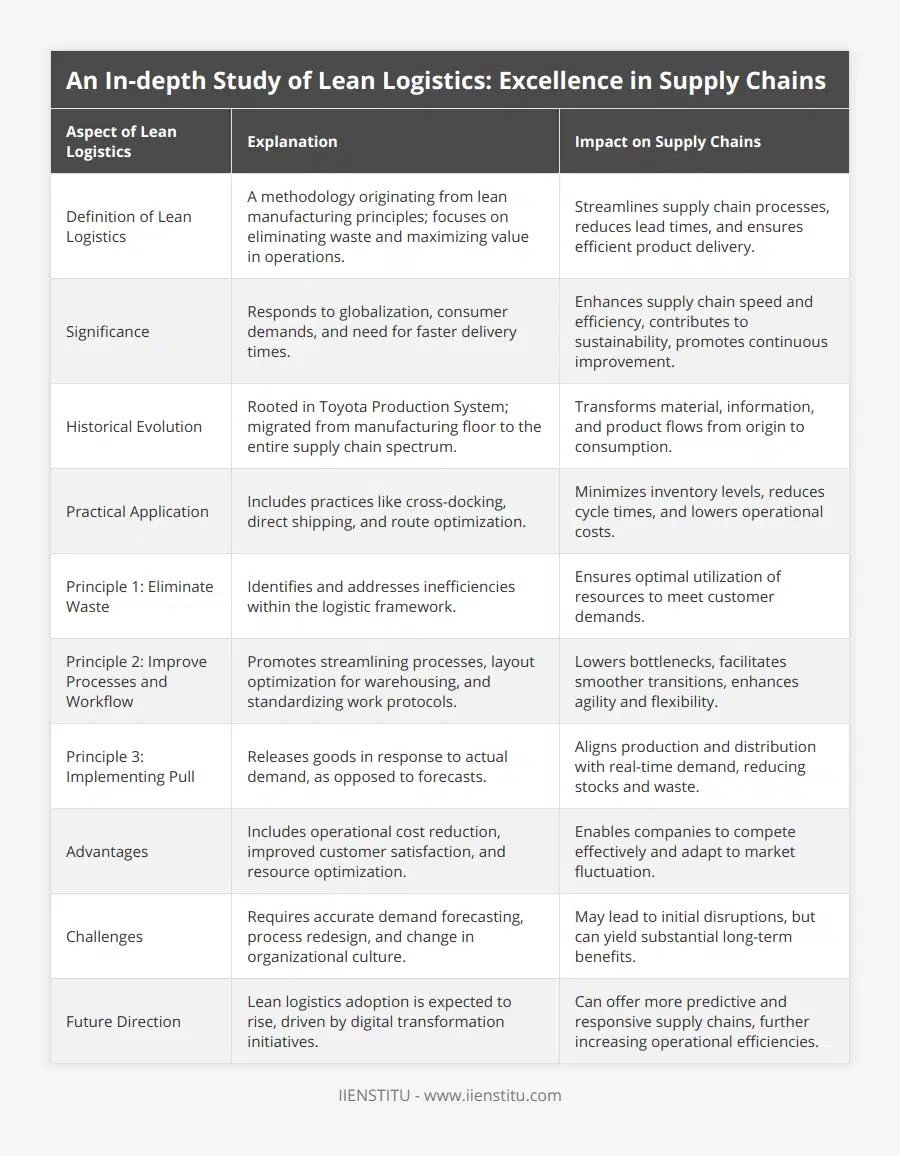
One of the most powerful lean logistics strategies is the use of pull systems, which ensure that products are only produced and delivered when there is actual demand from customers. This helps to reduce overproduction and inventory waste, while also improving responsiveness to changing customer needs. As Womack and Jones (2003) explain in their book "Lean Thinking," pull systems are a key enabler of lean logistics, allowing organizations to "sell one, make one" and "deliver one" in perfect synchronization with customer demand.
Another important aspect of lean logistics is the focus on supply chain collaboration and integration. In a lean logistics environment, all members of the supply chain work together as a single, cohesive unit, sharing information and resources to optimize performance and minimize waste. This requires a high degree of trust, transparency, and communication between supply chain partners, as well as a willingness to put the needs of the end customer first.
Of course, implementing lean logistics is not without its challenges. One of the biggest challenges is overcoming resistance to change within the organization. Many people are comfortable with the status quo and may be reluctant to embrace new ways of working. To overcome this resistance, leaders must communicate the benefits of lean logistics clearly and consistently, and involve employees in the change process from the very beginning.
Another challenge is the need for significant investments in technology and infrastructure. Lean logistics relies heavily on real-time data and advanced analytics to drive continuous improvement and optimize performance. This requires organizations to invest in modern logistics management systems, as well as in the training and development of their employees.
Despite these challenges, the benefits of lean logistics are clear. By eliminating waste, improving efficiency, and enhancing customer value, lean logistics can help organizations to reduce costs, improve service levels, and gain a competitive advantage in the marketplace. As the global economy continues to evolve and customer expectations continue to rise, the importance of lean logistics will only continue to grow.
In conclusion, lean logistics is a powerful approach to supply chain management that can help organizations to achieve unprecedented levels of efficiency, agility, and customer satisfaction. By focusing on value creation, continuous improvement, and supply chain collaboration, lean logistics enables organizations to eliminate waste, reduce costs, and deliver superior value to their customers. While implementing lean logistics can be challenging, the benefits are well worth the effort. As more and more organizations embrace lean thinking and apply it to their logistics operations, we can expect to see a new era of supply chain excellence emerge, one that is defined by innovation, flexibility, and an unwavering commitment to customer value.
References:
Liker, J. K. (2004). The Toyota Way: 14 Management Principles from the World's Greatest Manufacturer. McGraw-Hill.
Myerson, P. (2012). Lean Supply Chain and Logistics Management. McGraw-Hill.
Womack, J. P., & Jones, D. T. (2003). Lean Thinking: Banish Waste and Create Wealth in Your Corporation. Free Press.
Goldsby, T. J., & Martichenko, R. (2005). Lean Six Sigma Logistics: Strategic Development to Operational Success. J. Ross Publishing.
Baudin, M. (2004). Lean Logistics: The Nuts and Bolts of Delivering Materials and Goods. Productivity Press.
Zylstra, K. D. (2006). Lean Distribution: Applying Lean Manufacturing to Distribution, Logistics, and Supply Chain. John Wiley & Sons.
Frequently Asked Questions
What are the key principles of Lean Logistics and how do they contribute to excellence in supply chains?
Lean Logistics represents a strategic approach aimed at eliminating waste within supply chain operations. It hinges on several key principles that collectively promote efficiency and excellence.
Understanding Value from the Customer's Perspective
Lean begins with value. It is crucial to identify what the customer truly values. Only then can a business shape its logistics operations to deliver that value effectively. This customer-centric perspective ensures relevance and avoids unnecessary activities that do not contribute to the customer's desired outcome.
Emphasizing Value Stream Mapping
Identifying the value stream is a core lean principle. It involves mapping all processes and steps involved in the logistics operations. The map reveals the flow from product creation to delivery, highlighting value-adding and non-value-adding activities. Value stream mapping provides a clear blueprint for optimizing the flow of materials and information.
Pursuing Flow Efficiency
After mapping the value stream, the objective shifts to achieving a smooth flow of operations. Interruptions or bottlenecks in the logistics process add cost and time. Lean insists on creating a seamless flow with minimal delays. It thus increases speed to market and reduces cash-to-cash cycle time.
Creating Pull Systems
In lean logistics, push strategies give way to pull systems. Pull ensures that production or movement of goods occurs in response to actual demand, not forecasts. It emphasizes the importance of just-in-time delivery, where inventory levels closely match consumption rates. Pull systems decrease inventory costs and respond more quickly to customer needs.
Striving for Perfection Through Continual Improvement
The lean journey never truly ends. Even when value stream processes align with lean principles, there is always room for improvement. Lean promotes the practice of continuous improvement or kaizen. The aim is to perpetually seek out inefficiencies and refine processes to achieve a state closer to perfection.
Decentralizing Decision-Making
Lean empowers individuals close to the processes to make decisions. Faster, more informed decision-making at the operational level speeds up response times and enhances adaptability. Frontline employees often have the most direct understanding of value-adding activities, and empowering them improves agility and job satisfaction.
Standardizing Processes for Predictability
Standardization underpins repeatability and reliability in logistics operations. Well-defined processes ensure consistent outcomes. They serve as foundations for improvement, as deviations from standards help identify areas of waste or inefficiencies. Standardizing processes also simplifies training and cross-functionality within logistics teams.
Integrating Technology and Automation
Lean logistics leverages technology and automation for greater efficiency. Automation of repetitive tasks reduces errors and frees human resources for more valuable activities. Technology streamlines communication and data flow, providing real-time inputs essential for maintaining the logistics flow and for making informed decisions.
Balancing Flexibility and Efficiency
Lean does not seek efficiency at the expense of flexibility. Responsive supply chains can adjust quickly to changing demands or conditions. Lean logistics systems incorporate redundancy and variation planning, ensuring robustness against disruptions without significant waste.
Fostering a Culture of Excellence
The principles of lean logistics form not only a framework for operations but also a cultural shift. They instill a collective mindset focused on excellence within an organization. Developing this culture requires education, leadership, and a commitment to the lean principles.
Overall, lean logistics offers a philosophy and set of principles that, when diligently applied, result in superior supply chain performance. They drive operational excellence by eliminating waste, adding customer value, and continually improving towards the ideal of a seamless, responsive, and efficient logistics network.
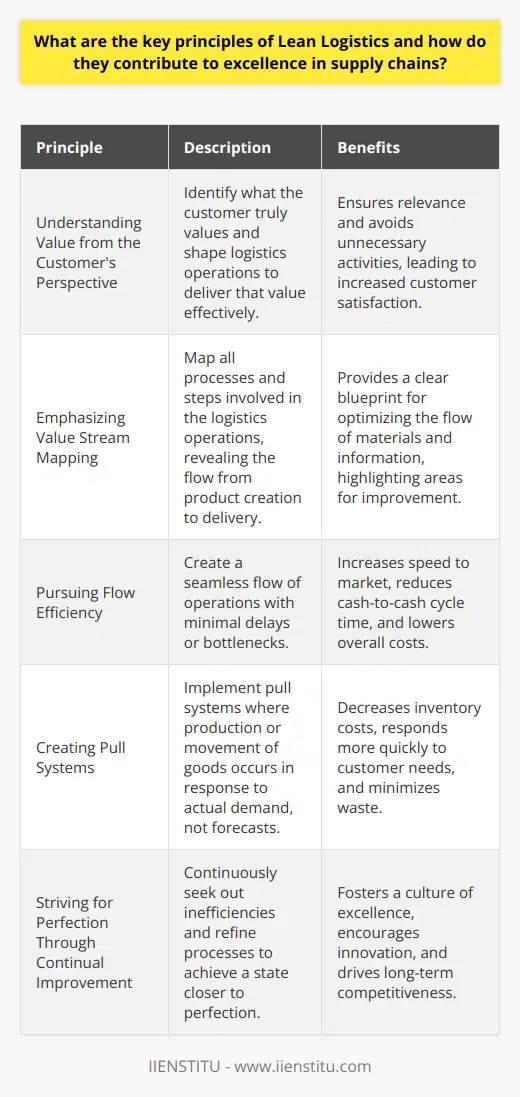
How does Lean Logistics optimize inventory and streamline the flow of products in a supply chain?
Understanding Lean Logistics
Lean Logistics is a methodology. It aims at efficiency. It reduces waste in supply chains.
Key Principles
Lean Logistics roots in Lean Manufacturing. It comes from the Toyota Production System. It values precision in production and waste elimination.
Waste Reduction
Lean Logistics targets seven types of waste. These are overproduction, waiting, transport, over-processing, inventory, motion, and defects. Lean Logistics seeks to remove these relentlessly.
Streamlined Processes
Every process must add value. That is a Lean tenet. Non-value-adding processes represent waste. Lean Logistics streamlines for value enhancement.
Optimizing Inventory with Lean
Lean Logistics optimizes inventory in several ways. It uses Just-In-Time delivery to reduce stock levels. Lean tools like Kanban facilitate this process. They signal when to move or produce items.
Reduces Holding Costs
Lean manages inventory to lower holding costs. Less stock means lower storage expenses.
Improves Cash Flow
Low inventory levels free up capital. They improve cash flow for businesses.
Enhances Responsiveness
Lean practices reduce lead times. They make supply chains more responsive. This means faster deliveries to customers.
Streamlining Product Flow
Lean Logistics simplifies product flow. It aligns supply with demand accurately.
Synchronization of Supply Chain
Lean Logistics promotes synchronization. It ensures smooth operations. This means aligning all supply chain elements.
Reduces Complexity
Lean reduces supply chain complexity. It simplifies transport and handling. This streamlines the product flow.
Enhances Quality and Speed
Lean focuses on quality. It reduces defects and speeds up the flow of products.
Conclusion
Lean Logistics improves efficiency. It optimizes inventory and streamlines product flow. It reduces costs and enhances performance. Businesses benefit from adopting Lean practices. They gain a competitive edge in their markets. Lean Logistics is crucial for modern supply chains.
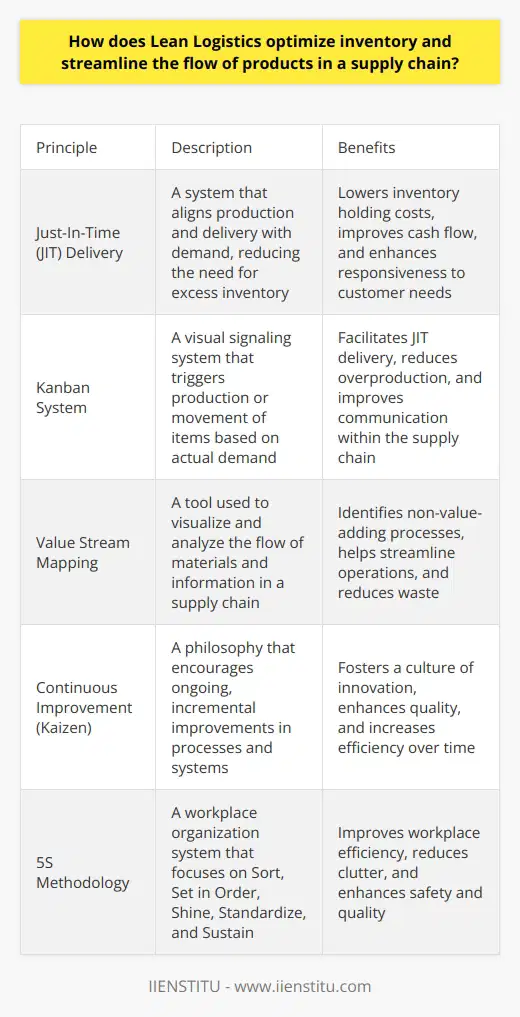
Can you elaborate on the ways Lean Logistics can mitigate risks and uncertainties inherent in the system of supply chains?
Understanding Lean Logistics
Lean Logistics draws from the broader Lean management philosophy. It aims to reduce waste. Lean thinking targets various inefficiencies.
Identifying Inefficiencies
The core inefficiency types include overproduction and unnecessary transport. Others are excess inventory and wasted motion. Lean logistics addresses these by promoting streamlined processes.
Risk Mitigation through Lean Logistics
Lean logistics plays a crucial role in mitigating risks. It focuses on greater visibility and adaptability which are key.
Enhanced Visibility
Lean Logistics involves continuous process monitoring. It promotes data collection and analysis. Real-time tracking is a hallmark. It allows for more informed decision-making.
Improved Collaboration
Supply chain partners need close cooperation. Lean logistics fosters collaboration. It does so through shared goals and aligned processes.
Inventory Management
Lean approaches recommend just-in-time inventory. It minimizes excess stock and associated holding costs. Agile response to demand changes becomes possible.
Supplier Relationships
Lean logistics relies on strong supplier ties. These relationships support consistent quality and timely deliveries. They help manage supply-related uncertainties.
Responding to Uncertainties
Lean logistics supports quick responses to fluctuations. It employs tools like Kanban systems. These enable flexible and efficient inventory control.
Process Standardization
Lean principles encourage standardizing operations. This creates predictability in workflows. It minimizes errors and disruptions.
Continual Improvement
Lean logistics is dynamic. It endorses regular review and adjustments. Operations can stay aligned with changing conditions.
Flexibility and Scalability
Lean systems are inherently flexible. They can scale activities up or down. This responsiveness mitigates risks associated with demand volatility.
Conclusion
Lean logistics offers a robust approach. It addresses uncertainties in supply chains effectively. Through waste reduction and enhanced operations, it paves the way for reliable, efficient supply chain management.
